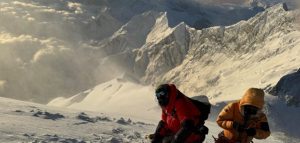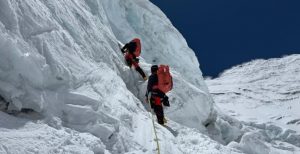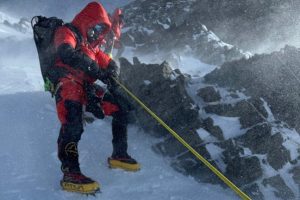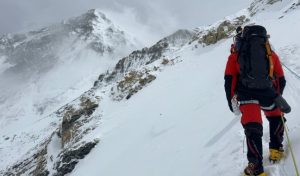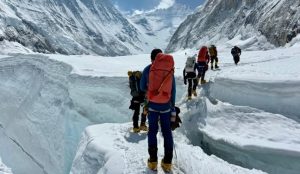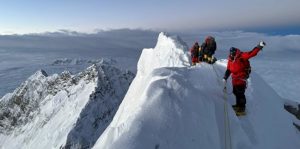Introduction: The British Army and Everest have been intertwined since long before the remarkable exploits of 1953 – surveying, attempting and admiring the vast slopes that lead to the roof of the World. One hundred years after Lieutenant George Mallory vanished above the clouds, the challenge remains ever gritty, demanding, and breathless. Unlike many major expeditions, Army Everest 2024 was developed not out of associations, but was inspired whilst climbing the mountain in 2019 as a privateer using operational savings. It was planned single-handedly with a very simple purpose: to enable any willing volunteer to achieve such a feat. Five years of training, delayed by a global pandemic, finally yielded a team and funding last year. It is a love story with our soldiers, their ability and sheer potential, at its very heart.
As the small aircraft squealed onto the tarmac in Lukla, the infamous airport marking the gateway to the Khumbu, Everest’s lower valleys were bustling with trekkers. The allure of the world’s highest mountain remains as potent as ever, and teams from every corner of the globe were venturing towards the sprawling glacier that marks the real start for the climb. The initial few weeks passed in a haze of smoky teahouses, dusty trails, and yak trains. Acclimatisation was purposely slow, allowing bodies to adapt to the thin air, retaining strength for the real challenges that were to take place above the snowline. Although the team of seven had endured an intense training pathway, for most this would be the first time they would experience such extreme altitude. The focus beforehand was simple: above all else to build up each individual’s cardiovascular base, to provide the body with the greatest potential to perform optimally when faced with ever depleting oxygen. The technical training was simple, long steep pushes in the Alps and Scotland, maximising time spent mimicking Himalayan climbing, especially when operational commitments only allowed for finite preparatory expeditions
The first push: After a week settling into Basecamp, the team were physically and mentally ready to run the gauntlet of the tumbling Khumbu Icefall and to acclimatise above 6000m. Daunting for any Everest climber, the delicate route that interweaves the colossal ice structures as it searches for the valley floor, is exceptionally difficult. Leaving the relative comfort of the firm base under the safety of nighttime temperatures, the team started to clamber up the route, squeezing through cracks, scrambling over house-sized ice blocks, and teetering across seemingly bottomless crevasses. Even for experienced climbers the icefall can be a nerve-wracking experience, totally vulnerable to overhanging ice that can tumble without warning. Climbing in single file, the headtorches weaved through the now illuminated blue ice, the stillness interrupted only by sporadic rock fall from the surrounding peaks. As morning broke, the end was in sight, with flattening ice and the sight of other teams’ tents in Camp One. Perched just above the icefall, the team would only settle here for a single night. It offered a brief respite but was less established than the hub of Camp Two, where the high-mountain planning could take place. However, It was badly needed, as the exertion of passing the first icefall was very evident and the team members crawled, exhausted, into their cramped tents.
The team woke early, as the passage to Camp Two needed to be nearly complete before the sun started beaming through the Western Cwm. This is so sheltered, that once the sun is high above, it can become excruciatingly hot very quickly, and for climbers, totally debilitating. Far less intense than the day before, much of the route to Camp Two is spent meandering around, and in some cases, jumping, over the vast crevasses that disappear into the icy abyss below. This meant moving as quickly as possible, as Camp Two was already in sight across the glacier by the time temperatures had risen acutely. The effect that altitude has on pacing can be astonishing, something that is amplified between Everest’s upper camps because most are in sight of one another; six, seven or eight hours of looking up to see the rest point, yet feeling so far away each time can be mentally punishing. This demands a steady, stoical attitude to prevent the mind from wandering, and to constantly remind oneself that the goal, however slow the progress, is getting steadily closer.
Climbing Everest from Nepal’s South Col will always be a popular choice, and regardless of controversy or mass disaster, there is only one highest mountain on the planet. Although there is significant risk in the Icefall, most of the upper slopes shed their winter snow early in the year and the risk of avalanche by the Spring is low. Maybe it is not entirely safe, but compared with other Himalayan giants, the mountain offers areas of safety and protection. This season was unlike that of recent years, with over 400 permits issued for climbing and one operator selected as the route- fixing team. What was different though was the delay it took for the fixing team to even start to work on the high mountain. With good weather for much of early May, it was expected to be a very early start, but the evident effects of climate change hampered such aspirations. Little snowfall left the Icefall jagged, and the normally snowy upper slopes showed vast fields of blue ice. To add further friction, the commercial politics, secrecy, and downright conflict of interests of operators controlling the mountain in the absence of Government control took hold, and it was anyone’s guess when they would finish. The team, healthy and comfortable in Camp Two, decided to try and out-manouvre this obstacle, staying high and poised for an early summit attempt. Four days and a thousand games of Monopoly-Deal later, the team were ready to launch. The summit was fixed, commercial outfits days behind, and the weather forecast looking stable. As the team left Camp Two, clad in down suits and carrying heavy loads to sustain them for four days, it all suddenly became very real indeed. This self-sufficiency and sustainment was key throughout the expedition; although central fixing must be adhered to on Everest, the team hauled their own loads, made their own decisions, and earned their right to be there.
Rising from the Western Cwm, the Lhotse Face soars abruptly from the gentle slopes, piercing the sky at sixty degrees. Traversing the lower bergschrund, the team hooked onto the lines to start the seemingly infinite ascent to Camp Three and beyond. Safety above an anchor, then jumar, then reposition safety, two steps, slide jumar. A process that would be repeated hundreds of times over the two vertical kilometres between there and the summit, all in a line and with just the sound of crampons crunching in the snow, Everest demands each climber be patient and comfortable in their own thoughts. Heavy legs are forced to keep moving upwards and each strenuous movement is met with lung-busting breathing. Even before reaching Camp Three, oxygen levels are below sea level and decreasing fast; mundane tasks become a real challenge as the thin dry air saps energy. Soon though, smiles break out on faces huddled on an icy perch carved into the Lhotse Face, a place to set camp protected from any slides and nearly halfway to the South Col.
A welcome rest at Camp Three re-energised the team, even if the small shelf dug into the steep face made for worrying toilet prospects. Either risk terrorising fellow tentmates by using the small porch or find a patch of stable snow on a near-vertical cliff to spend that moment. Movement and rest hereafter was to be supplemented by extra oxygen, allowing for consistent speed and, ultimately, assisting blood flow to vulnerable extremities. Under the moonlight of the early hours and with sleeping bags hastily stowed, the team meandered among the tents and reattached themselves to the Lhotse Face for the next vertical kilometre to Camp Four. Snow fellsteps andility was poor as the ascent continued to the Yellow Band, via a few hundred metres of rocky steps, and grinding crampon placements. Balancing on the first step, the team were rewarded with a view of the horseshoe to the Geneva Spur and the South Col beyond. The sheer exposure overwhelming and the smallest misstep causing snow and ice to tumble hundreds of metres down. towards the Western Cwm. Eyes were honed simply on the next placements and water bottles were shared with caution. Finally, above the Yellow Band, the last traverse of Lhotse’s upper slopes led to a small gulley and the apex of the Geneva Spur. Camp Four lay hidden behind and was seemingly within touching distance, yet it took another four hours of repetitive step, step, jumar, step, step, before it became a reality.
Thirty metres beneath the South Col, the relentless, piercing sun had taken its toll on the team. For nearly ten hours they had been ascending, first through horrifying cold and now, in baking heat, trapped in all-encompassing down suits. Stumbling onto the flat reprieve of the Col raised spirits, even if it was to be short lived with an overnight push to the summit looming. Inside the tents, the team resorted to very personal routines: incessantly sorting kit, forcing down food, or simply listening to music imagining they were somewhere else entirely. And, just like that, the sun set and the climbers’ headtorches poked once again from the tents’ entrances. Silent fist bumps, buddy- buddy checks and embraces marked the start of the ultimate aim of the expedition. With hearts racing, the team headed beyond the point of rescue and into the looming dark clouds which hung above 8000m. Overnight the team climbed relentlessly, storming above the Balcony in hours less than planned. Cocooned in cumbersome down suits, with hissing masks and dark goggles, each climber faced a distinctly personal battle in profound loneliness.
As dawn broke beneath the South Summit the wind rose eerily and intermittently. By now the team were at a greater height than on any other mountain on the planet, a stone’s throw from the summit and days into the endeavour. However change was afoot, and the gentle winds grew rapidly, and moments of eerie stillness were abruptly shattered as unearthly blasts whacked the mountainside. Radios suddenly crackled into life as panicked forecasters called through to Basecamp, 60-70mph winds had blown up and anyone at height was in imminent danger. Perched on the near vertical rock step cresting the South Summit, the team immediately made the unanimous decision to descend – a decision that would mean having to endure another complete summit attempt if strength allowed, but one that definitely had to be undertaken. Rapidly descending to the Balcony, the team engaged with some climbers who had seemingly ignored the winds and were without radios. Here, multiple team members spoke to a Mongolian duo, and offered radio confirmation. Politely declining, both climbers were to succumb to the mountain the following night, exposed to the ferocious brutality of the jet stream.
The descent beneath the balcony revealed the full force of the wind’s fury; steep snow slopes slid beneath the feet and fought against the climbers. In the distance the yellow dots of Camp Four tents looked calm and welcoming, a potential shelter from the elements and a marker of safety for which to aim. Such hopes were quickly dashed as the Col was also beaten into submission with torn fabric and strewn equipment. The team had no choice but to continue straight through onto the Lhotse Face, moving continuously for nearly 26 hours. Resting at each anchor briefly, the inner strength to stand and descend was unanimously felt; never giving in to the mind’s attempts to trick one into falling asleep or staying too long in one place. Regardless of the following chapter and the summit photos, the actions on this day in early May were the most successful of the expedition. The team was deeply bonded through adversity and unanimously agreed, without hesitation, to take the necessary life-saving decisions. This was a team that stopped at Camp Four only to collect sleeping bags, and descended without food or water; a team that dug into the depths of its reserves of endurance and kept going without question; a team that by nightfall was huddled seven abreast, asleep and safe, in Camp Two.
Taking stock and regrouping over the next few days sheltered in the Western Cwm, the team considered its options. To rescale the upper slopes would take a gargantuan effort and although comfortable, 6400m is no place to rest weary bodies. Four of the originals were motivated to return, but they needed time, thick air and good food. Ten days at this height has a significant impact on the body, and most climbers had already lost ten percent of their body weight. An option to hitch a lift on helicopters returning to Kathmandu was seized, knowing that the weather window would be there for some time yet.
The second push: Returning to Base Camp, the towering icefall shimmered in the morning sun, tumbling nearly a kilometre from the Western Cwm onto the glacial moraine below. The incessant whirring of the helicopter broke the total silence shared by the team; staring at the challenge ahead, engrossed in thought and internally boosting the determination to reattack. To maximise the chances of success and to avoid commercial climbers, almost the entirety of the second push was to be conducted at night, creeping through vast crevasse fields and scaling steep slopes under the power of headtorches, whilst the rest of the mountain slept. Movement would be fast, stopping only to rest up during the day avoiding the blistering heat of the Himalayan sunshine than beat onto our down suits disrupting sleep, hours from shade and respite. Utterly acclimatised after two weeks above 6500m, the team stormed back through the Icefall. The lingering seracs and constant overhanging ice still created a deep sense of unease for those within; the risk, totally beyond one’s control, was lessened only by the speed each climber could move over, across, and through obstacles. Crampons bit into the hard snow and clinked on the horizontal ladders as the team pressed on, the magnitude of the route, the challenge, and the altitude gain dominating the mind as the hours of quiet movement passed.
Although technically speaking, Everest isn’t a huge mountaineering challenge, the route is extremely long and physically demanding. The vertical kilometres from Base Camp are lung- busting and the u-shaped route, totally draining. To get so close on the first attempt, and then return within a week is unheard of amongst western climbers; the strength of our soldiers to do so is testament to the quality of our people; acutely aware of how to recover, pace, and summon the strength to push against overwhelming adversity. Apart from kinetic operations, this is a true demonstration of how good our very best are.
Spanning several kilometres high above the icefall, the gentle icy floor of the Western Cwm stretches between Everest, Lhotse and Nuptse. Sheltered from the outside world, it is the base of the greatest amphitheatre on the planet. From here the route all the way to Camp Four is visible, snaking between the ice and rock bands of the terrifyingly steep Lhotse Face. Clambering over the last rock step at first light onto the South Col, the team were faced with similar winds to those that had scuppered the first attempt. Seeking refuge in a dishevelled tent, patience was to be key throughout the day, in the hope that the winds would subside and a possible summit push present itself. Sealed inside, wrapped amongst warm sleeping bags, for a team, the South Col can prove to be utterly treacherous. The risk of not waking from deep sleep is very real and the mind must stay constantly aware of the need to escape if required. As the day progressed, the routine was utterly simple; eat, drink, and not overthink the physical challenge that still lay ahead.
Without a break in the fierce winds, getting corroboration of as many weather forecasts as possible took most of the afternoon. Texting as many climbers, teams, and forecasters from the inReach device provided tangible evidence that the weather would calm just before last light. Keen to get ahead of any teams hidden amongst the surviving tents of the South Col, the team broke cover just before 18:00 to begin what felt like the longest of nights. Ascending the lower slopes to Everest’s balcony as the sun set, the team stayed close, systematically taking a rest after each 20-step exertion. The team would be over halfway towards the summit before headtorches emerged from the South Col below. A cunning plan, maybe, but a plan that would encompass a brutally full period of darkness with temperatures below -30˚Celsius.
Cresting onto a small plateau, a planned rest stop was harshly interrupted by the discovery of a Sherpa and his Nepali client, perched on the flat rock, the ice covering the fabric of their down suits almost camouflaged them against the environment. It soon became apparent that they had been there since the previous day, trapped above 8400m after the client had fallen ill; we later discovered that they had successfully summited, but the ill-effects were too great to allow him to descend further. Huddling as a team, the summit push was temporarily paused whilst a triage could take place to decide what could be done. The client, Binod, in the dreadful latter stages of cerebral and pulmonary oedema, was almost unconscious and drastically frostbitten. Without communication devices, it is disturbing to think that whilst strong teams rested only a few hours below, no one was aware of what might have been a successful rescue situation above.
By now though, it was too late. Pitch black, thirty-below and a day above the nearest helicopter landing-zone, the man was close to death. Regardless, the team unpacked spare oxygen bottles, one to allow the Sherpa to survive and descend, the other to allow Binod to be pain free as he succumbed to the effects of altitude and cold. Acting with absolute dignity the team propped him up, secured his clothing and gently brushed the snow from his near-frozen face. There, under the piercing full moon of the Himalaya, his last moments were spent in the hands of people of a different religion, people from a foreign land, people who cared.
The team crouched close together on the balcony to change oxygen, refuel, and ultimately, share the supportive camaraderie needed after the challenging moment below. Nevertheless the night was far from over, as the hideous winds of previous nights had blasted the route ahead, with the ropes disappearing under deep snow. Traversing to the South Summit’s last face, the team broke trail on extremely steep terrain. Stumbling, slipping and causing small slides, with adrenalin racing through tired bodies, no one was able to hear the expletives muttered under the masks which were lost amongst the winds. Reaching the shallower slopes near the Roof of the World gave the Army team a respite and allowed a gentler pace as it neared the point of the turnaround the previous week. The hours passed the same as they had below, the steps between rest periods lessening as the altitude and breathing increased. Then, very suddenly, the narrow descent to the rocky corner of the South Summit presented itself under the strained headtorches. The beams scanned the empty and narrow ridge ahead, searching for the final stretch to the summit and the lonely snow that sits at the highest point on Earth. A quick and rather disappointing break amongst the rocks revealed frozen water bottles and ever-hardening energy bars. The sun would solve this problem in a few hours, so, once again the team pushed relentlessly on.
Approaching the dark summit, the bright colours of Tibetan prayer flags broke the monotone vistas of the past night. The realisation of the moment was overwhelming, the team grasped one another, and shared muffled celebrations; smiles were painful as frozen saliva snapped around mouths. It was 03:51, under a full moon, seven years after the last Army team, and exactly a century since the first Army Officer probably made it, the relationship was rekindled in peaceful glory. No one conquers Everest. Those who get to stand atop are simply lucky to have been granted safe passage; the greatest privilege of all is simply to see the World from such a unique perspective; when even the biggest mountains on the planet seem small. It is an experience which puts life’s personal woes fully into perspective. Twenty minutes passed in a flash, and as dawn broke across the Tibetan plateau it almost instantly illuminated the vast, endless panorama of the Himalayas. The welcome warmth reignited spirits for descent, while Everest’s pyramid cast an immense shadow stretching towards the East.
Afterthought: Five years in the making, the dream to return to Everest, with soldiers afforded the training and resources to achieve something amazing, had become a wonderful reality. The fact that they all come from the most operationally busy part of Defence is a double-positive, not only enhancing their performance professionally, but also diversifying and strengthening their experience. Everest’s physical demands, its cognitive stretch, and the necessary requirement for leadership and teamwork is unmatched by anything outside the most extreme operations. Deep-rooted in our history, Adventurous Training, especially at this level, is an exceptionally powerful tool for the development of our people. The soldiers and officers involved should remain eternally proud of their immense efforts and impeccable conduct amongst the harshest conditions, high above the clouds.

